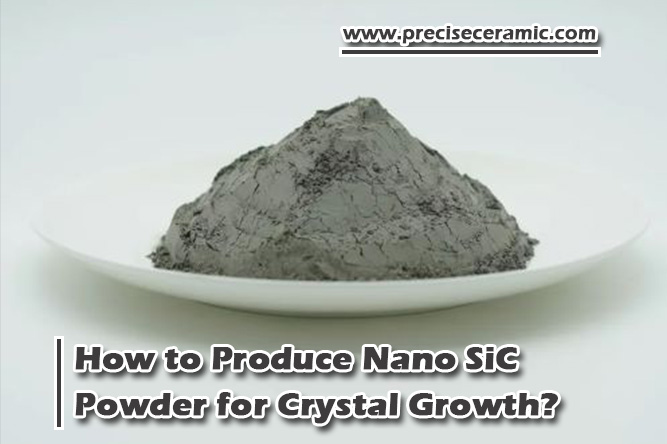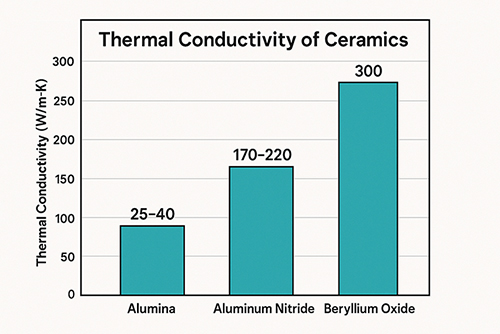How to Produce Nano SiC Powder for Crystal Growth?

Introduction
Silicon Carbide (SiC) crystal is an ideal semiconductor material for its great thermal conductivity, wide bandgap, and high voltage breakdown resistance. To get such advanced material, we should pay high attention to the particle sizes, packing density, and other factors in the manufacturing process. Most importantly, high-purity nano SiC powder as the raw material is required.
Here, this article is going to introduce different methods to produce high-purity nano SiC powder for crystal growth. Hope that you can have a basic understanding of silicon carbide ceramic and silicon carbide crystal.
Raw Materials: Alpha SiC Powder & Beta SiC Powder
The manufacturing methods of nano SiC powder vary greatly, yet all of them choose beta SiC powder instead of alpha SiC powder as the raw material. The reason is listed as follows.
- Lower Smelting Temperature: The processing temperature of beta SiC is about 1500-1600 °C, while the smelting temperature of alpha SiC exceeds 2400 °C. So, the beta SiC is much easier to refine.
- The Perfect Cubic Structure: With a cubic, spheroidal crystal structure, the beta SiC has a better cutting and polishing effect compared with the hexahedron alpha SiC.
- Higher Hardness: The hardness of beta SiC is much higher than that of alpha SiC. Consequently, it finds applications in superfine grinding.
- Better Conduction: Beta SiC possesses better electrical conductivity and thermal conductivity, making it a popular material to make semiconductors and heat exchangers.
Related reading: An Overview of Silicon Carbide Ceramic Materials

Figure 1. Nano Silicon Carbide Powder
Methods to Produce Nano SiC Powder
A range of methods is employed to obtain high-purity nano silicon carbide powder. Generally, the production process could be divided into three steps--preparation, heating, and further purification.
1 Acheson Method
The Acheson process is commonly used to produce SiC powder.
- First, you need to combine powdered coke and quartz together.
- Thereafter, heat the mixture at 1700–2500° C using the energy provided by the resistive heating of a graphite core.
- You can acquire refined SiC powder after hours of heating.
2 Carbo-thermal Reduction
Although the Acheson method has been used for years, its reaction time is too long, and the operating temperature is too high. Thus, manufacturers developed a new carbo-thermal reduction means, where you just need to heat the furnace to 650° C, and niobium is added as an additive to promote product purity.
3 Microwave Synthesis
You can get SiC powder through microwave heating. This method is much simpler because there is no need for inert gases and further purification. Besides, the preparation is quite different. Instead of utilizing pure silicon powder, this process selects silica and activated carbon in the beginning.
4 Chemical Vapor Deposition (CVD)
SiC powders could be prepared by chemical vapor deposition.
- First, (CH3)2SiCl2 and H2 are employed as source gases.
- Second, heat these materials at a temperature of about 1273 K.
- Finally, various kinds of spherical SiC powder are formed, including amorphous powder, beta powder, and composite powder.
5 Sol–gel Processes
Silicon carbide is synthesized with the sol-gel step.
- Prepare a mixture of SiO2 and carbon first. A transparent gel is also added.
- The following step is a heat treatment at 1200–1500°C under a dynamic vacuum.
- You would get highly dispersed nano-sized silicon carbide powder using the sol-gel technique.
6 Combustion Synthesis
Combustion synthesis (CS) is a useful technique to produce high-purity SiC powder. It can be classified into two types: propagating high-temperature synthesis (SHS) and volume combustion synthesis (VCS). In SHS, raw materials are heated locally, then, the reaction propagates, while all the materials are heated together, and the reaction starts simultaneously in VCS. Both SHS and VCS are energy-saving and easy to follow.
Related reading: Main Production Methods of Silicon Carbide Ceramics
Conclusion
Various methods such as the Acheson process, carbo-thermal reduction, and combustion synthesis, are used to produce high-purity nano silicon carbide powder for crystal growth. Advanced Ceramic Materials (ACM) is a leading supplier of nano silicon carbide powder and numerous quality ceramics. Send us an inquiry if you are interested.
{{item.content}}
LEVE A REPLY
{{item.children[0].content}}
{{item.content}}
LEAVE A REPLY
SUBSCRIBE OUR NEWSLETTER
- Boron Nitride in Cosmetics: Enhancing Performance and Sensory Appeal
- Maximize MOCVD Yield and Purity with Hexagonal Boron Nitride Setters
- What Are the Advantages and Uses of Boron Nitride Ceramic Sheet?
- The Compression Annealing Advantage for Pyrolytic Boron Nitride
- Beyond Insulation: The Surprising Spectrum of Ceramic Thermal Conductivity











